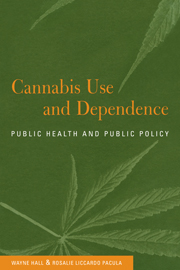Book contents
- Frontmatter
- Dedication
- Contents
- List of figures and tables
- Foreword
- Acknowledgements
- 1 Introduction
- Section 1 Cannabis the drug and how it is used
- Section 2 The health effects of cannabis
- Section 3 The psychological effects of chronic cannabis use
- Section 4 Effects on adolescent development
- 10 Is cannabis a gateway drug?
- 11 Adolescent psychosocial outcomes
- Section 5 Harms and benefits of cannabis use
- Section 6 The effectiveness and costs of cannabis prohibition
- Section 7 Policy alternatives
- Appendix 1
- Appendix 2
- References
- Index
10 - Is cannabis a gateway drug?
from Section 4 - Effects on adolescent development
Published online by Cambridge University Press: 05 July 2016
- Frontmatter
- Dedication
- Contents
- List of figures and tables
- Foreword
- Acknowledgements
- 1 Introduction
- Section 1 Cannabis the drug and how it is used
- Section 2 The health effects of cannabis
- Section 3 The psychological effects of chronic cannabis use
- Section 4 Effects on adolescent development
- 10 Is cannabis a gateway drug?
- 11 Adolescent psychosocial outcomes
- Section 5 Harms and benefits of cannabis use
- Section 6 The effectiveness and costs of cannabis prohibition
- Section 7 Policy alternatives
- Appendix 1
- Appendix 2
- References
- Index
Summary
Cross-sectional surveys of adolescent drug use in the United States and elsewhere have consistently shown three types of association between cannabis use and the use of other illicit drugs, such as heroin and cocaine (Morral et al., 2002).
First, American adolescents during the 1970s and 1980s showed a typical sequence of involvement with licit and illicit drugs in which almost all who tried cocaine and heroin had first used alcohol, tobacco and cannabis (Kandel, 1975; Kandel, 2002). The sole exception to this generalisation has been found in samples of inner city youth for whom a wide range of illicit drugs are more readily available (Golub and Johnson, 2002).
Second, during the same period there was a strong relationship between regular cannabis use and the later use of heroin and cocaine. Kandel (1984), for example, found that only 7% of American youth who had never used cannabis reported using another illicit drug. This figure was 33% among those who had used cannabis, and 84% among current daily cannabis users. The same relationships have been observed in surveys of drug use in Australia (Donnelly and Hall, 1994).
Third, the earlier the age at which any drug was first used, the more likely the user was to use the next drug in the sequence (Kandel, 1978; Donovan and Jessor, 1983; Kandel, 1984, 1988; Kandel, 2002). So those who begin to use alcohol and tobacco at an early age were the most likely to use cannabis; early cannabis users, in turn, were more likely to use hallucinogens and ‘pills’ (amphetamines and tranquillisers); and early users of ‘pills’ were, in turn, the ones most likely to use cocaine and heroin.
The relationships between cannabis and heroin use found in the cross-sectional studies have also been reported in longitudinal studies of drug use. In one of the first such studies (Robins et al., 1970) followed-up 222 African-American adolescents identified from school records until age 33 and interviewed them about their drug use in adolescence and young adulthood. They found that young men who had used cannabis before the age of 20 were more likely to use heroin than those who had not.
- Type
- Chapter
- Information
- Cannabis Use and DependencePublic Health and Public Policy, pp. 104 - 114Publisher: Cambridge University PressPrint publication year: 2002



